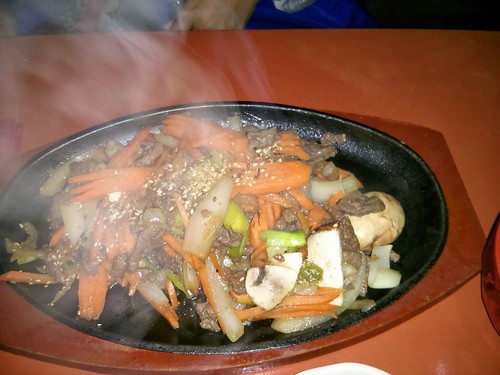Bulgogi refers to Korean's quintessential food made of marinated and grilled beef . Beef is sliced thinly then marinated in seasoning before being grilled. The marinade includes pear juice or sugar, soy sauce, minced garlic, diced green onion, sesame oil.
Picture below is the Bulgogi in one of the Korean Restaurants in Bremen, Germany.

Description
Bulgogi is a popular Korean dish made of thinly sliced beef marinated in a Blend of soy sauce, sugar, sesame oil, garlic, and other seasonings. The meat is typically grilled or cooked on a stovetop, resulting in a tender and flavorful dish. Bulgogi is known for its savory-sweet taste and is often served with rice and a variety of side dishes.
The marinade for Bulgogi typically includes ingredients like pear, onion, and ginger, which help tenderize the meat and add depth of flavor. The dish can be easily customized with different spices and seasonings to suit individual preferences. Bulgogi is a versatile dish that can be enjoyed on its own, in lettuce wraps, or as part of a stir-fry.
Due to its delicious flavor and ease of preparation, Bulgogi has gained popularity around the world and is a favorite dish among fans of Korean cuisine. It is a great option for a satisfying and satisfying meal that is sure to please a crowd.
Application Areas
- Restaurants serving Korean cuisine
- Home-cooking for family meals
- Food trucks specializing in international dishes
- Catering for events and parties
- Asian fusion restaurants incorporating Korean flavors
Treatment and Risks
- Cooking Bulgogi thoroughly helps reduce the risk of foodborne illnesses from raw meat
- Marinating the meat properly can help enhance the flavor and tenderness of the dish
- Be cautious of cross-contamination when handling raw meat and marinade ingredients
- Store leftover Bulgogi in airtight containers in the refrigerator to prevent spoilage
Examples
- Bulgogi served with steamed rice and kimchi
- Bulgogi lettuce wraps with ssamjang sauce
- Bulgogi stir-fry with vegetables and noodles
- Bulgogi sliders with pickled radish
- Bulgogi bibimbap topped with a fried egg
Similar Concepts and Synonyms
- Korean BBQ
- Grilled marinated beef
- Beef bulgogi
- Korean beef stir-fry
- Galbi-marinated beef
Articles with 'Bulgogi' in the title
- Yachae-bulgogi: Yachae-bulgogi means Bulgogi with vegetables, a Korean food made of Bulgogi served with vegetables.
- Yachae-bulgogi-jeongol: Yachae-bulgogi-jeongol is Bulgogi and vegetables hot pot in broth. It is a Korean hot pot made of Bulgogi and vegetables in broth
Summary
Bulgogi is a traditional Korean dish made of thinly sliced beef marinated in a sweet and savory sauce, typically grilled or cooked on a stovetop. With its delicious flavor and versatility, Bulgogi has become a favorite dish among fans of Korean cuisine worldwide.
--
Related Articles to the term 'Bulgogi' | |
| 'Neobiani' | ■■■■■■■■■■ |
| Neobiani is a type of Korean grilled dish served in royal cuisine. It is thinly sliced beef marinated . . . Read More | |
| 'Marinade' | ■■■■■■■ |
| Marinade is referring to blend of oil, wine or vinegar, herbs and spices used to flavour and tenderise . . . Read More | |
| 'Namul' | ■■■■■■■ |
| Namul is a Korean term meaning \"vegetables\" or \"wild greens\" dishes. Namul refers to a traditional . . . Read More | |
| 'Day Lily Namul' | ■■■■■■■ |
| Day Lily Namul refers to a Korean food made of blanched day lily stems which are seasoned with soybean . . . Read More | |
| 'Tteok-Kkochi Gui' | ■■■■■■■ |
| Tteok-Kkochi Gui refers to Korean food of grilled skewered rice cake stick with assorted vegetables. . . . Read More | |
| 'Inihaw na Manok' | ■■■■■■■ |
| Inihaw na Manok in the food context refers to a Filipino dish of grilled chicken. This popular dish is . . . Read More | |
| 'Inihaw na Liempo' | ■■■■■■■ |
| Inihaw na Liempo in the food context refers to a Filipino dish consisting of grilled pork belly. Known . . . Read More | |
| 'Minchi' | ■■■■■■■ |
| Minchi refers to one of the popular Macau or Macanese dishes made of minced beef with fried potatoes, . . . Read More | |
| 'Baechu-geotjeori' | ■■■■■■■ |
| Baechu-geotjeori: Baechu-geotjeori (Spicy Chinese Cabbage Salad Kimchi). It is a Korean salad made of . . . Read More | |
| 'Inihaw na Baboy' | ■■■■■■ |
| Inihaw na Baboy in the food context refers to a Filipino dish consisting of grilled pork. The term \"inihaw\" . . . Read More | |
